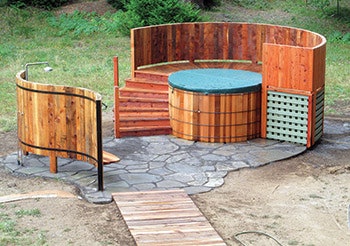If you know anything about the history of portable spas, you know wooden barrel hot tubs helped launch the modern hot water industry. Yet with advent of composite materials, fancy hydrotherapy jet arrays, ergonomic designs and control technology, the popularity of the wooden barrel tub has since waned — or has it?
RELATED: Born in the USA: The History of Portable Spas
According to wooden hot tub manufacturers and those who sell and install the systems, despite the market dominance of acrylics, there remains a distinct — if not increasing — market for tubs made out of wood, even those that can be heated by wood fire.
 courtesy of Snorkel Hot Tubs
courtesy of Snorkel Hot Tubs
Fully evolved from their wine vat predecessors, today's wooden tubs can offer close to, or even the same, features and comforts of today's portable units. Yet as has always been the case, wooden hot tubs hold appeal for those who value natural materials and experiences and on some level, alternatives to modernity.
According to Tom Slater, president of Snorkel Hot Tubs, "There's an elemental quality to the appeal. It's wood, water, fire and air. The product has changed and in some ways has become more sophisticated, but you never get too far away from that natural aspect."
A DIFFERENT PARTY
 courtesy of Snorkel Hot Tubs
courtesy of Snorkel Hot Tubs
What has truly changed, even more than technical sophistication, is the association the tubs have with the decadence and partying lifestyles of the '70s, says Robert Ghelerter, founder of Robert's Hot Tubs, a company that was very much in the thick of the lifestyle appeal when it started in in 1976. He immediately dismisses any notion that the original reputation of his products has relevance in today's market:
"It was certainly part of the prevailing social attitudes of the time, but we really don't sell to hippies anymore," he says. "The partying aspect has mostly worn off."
Instead, what he sees in his clientele are those who enjoy luxury, nature and have the resources to indulge those preferences. "Our clients are mostly affluent — doctors, lawyers, successful businesspeople, etc. It's an expensive product, so most of our customers are well off, and a large percentage are middle aged or older. There's no question they enjoy the natural material as opposed to acrylic. It's all part of the allure of the product; the look, feel and smell are different."
"It's almost impossible to define the audience by demographics," Slater adds. "There's a tendency to assume they're people who might fit a certain type, but really we've found that homeowners who turn to wooden tubs are extremely diverse."
 courtesy of Snorkel Hot Tubs
courtesy of Snorkel Hot Tubs
Regardless of typical client profiles, both men see their numbers climbing, albeit slowly. "It's difficult to quantify," Slater says, "but there's little question these types of tubs are experiencing greater acceptance than they did 20 years ago. It's slow growth, more like a glacier than a tsunami, but the market is moving in a positive direction."
"We're also seeing increases in the U.S. market, in part certainly because the economy is doing well," Ghelerter adds. "And as we all know, the spa industry in general is based entirely on discretionary income.
"Currently about a third of what we make goes to Europe. We have new companies over there that are interested in showing our tubs, so we're confident it's going to grow even more."
TAKING CUES
Because wooden hot tubs have been forced to coexist with modern portables, they now include same types of features, like ergonomic accessories.
"I guess we're trying not to be a total dinosaur in that sense," Ghelerter says. "We have decking that goes around the tub, bench seating and steps, in different configurations. What they're looking for varies a lot but I'd say it's therapeutic value for most people. You can be fully immersed in them; we can make them as deep as you want, so from a therapy and relaxation stand point, they do offer a different experience than what you find in an acrylic spa."
In terms of function, wooden hot tubs have likewise incorporated hydrotherapy jets as well as modern water treatment and heating technology. Snorkel Hot Tubs, for example, offers ionization water-treatment systems as well as tubs with jets.
 courtesy of Roberts Hot Tubs
courtesy of Roberts Hot Tubs
By the same token, most of the company's units are equipped with wood-fired heaters, although gas and electric versions are also available. While the need to build a fire rather than simply activate a heater seems to run counter to many homeowners' desire for ease of operation and overall convenience, the natural wood fire option does hold an appeal for some.
"I compare it to people who would choose a sailboat over a powerboat," Slater says. "It's more effort, but the process of building the fire is part of the mystique for some people. It's also great for properties that don't have power or utilities, and surprisingly those customers are still out there."
ORIGINAL REDWOOD NO MORE
To be sure, the primary appeal remains the wooden construction, most of which is still very much based on traditional cooperage and woodworking techniques. For the 40-year veteran Ghelerter, the quality of construction and design traditions are still very much part of the product's appeal.
"There is an idealistic aspect to it," he says. "After college I joined a woodworking collective and spent a year and a half in Japan where I studied Japanese woodworking techniques. I was fascinated by the design philosophy and woodworking craft as it's practiced in Japan, and I came away with a different sensibility. Over the years since then I've always enjoyed working with wood. It's nice to look at, it's nice to smell, and every piece is different. It's a pleasure to be around and to work with."
One of the biggest changes, however, has been the type of wood used. In the early days, wooden hot tubs were often made of redwood, particularly old-growth redwood, which proved both beautiful and durable, but largely unsustainable from an economic standpoint. Regulations restricting the foresting of old-growth redwood groves have forced manufacturers to turn to other wood species that are more plentiful and less expensive.
Today, the different types of cedar grown in the Pacific Northwest, Canada and Alaska have taken over as the material of choice, and in some cases teak imported from tropical countries.
"It's largely a matter of supply," Slater says. "But the material also has characteristics that make it well-suited for the application. The dimensional stability, insulating qualities, and rot resistance make it the perfect choice for premium building material applications including shingles, decking, fencing and siding. All that plus its sauna-like aroma also make it ideal for hot tubs."
SUSTAINABLE JOY
While it's reasonable to assume that wooden hot tubs will remain a niche market, it likewise appears as though they're here to stay as a preferred choice for homeowners who value both the therapeutic benefits along with the natural material and traditional look.
"It's the aesthetic of the product that draws people," Ghelerter says. "Also, because it's created naturally, that really appeals to a certain segment of the market."
"I do enjoy the fact that 'tubbing' is both healthy and fun," Slater adds. "There's no question that for customers who prefer the look of the tubs and the material will continue to look for alternatives."
Comments or thoughts on this article? Please e-mail [email protected].








































